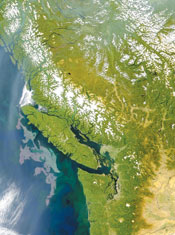Dr. Tracy Collier
Director
EC Staff Directory
EC Org Chart
Programs/Teams
Ecotoxicology
Nathaniel Scholz
• Hazard Assessment & Risk
Modeling
• Immunology
• Fish Neurobiology &
Development
• Pathology
• Reproductive Toxicology
Environmental Assessment
Gina Ylitalo
Harmful Algal Blooms
Dr. Vera Trainer
Watershed Program
Dr. Philip Roni
• Ecosystem Processes
• Landscape Ecology &
Recovery Science
• Restoration
Research Publications
• By year
• By document type
Issue Papers
Research Activities
|
|
 Washington coast phytoplankton bloom
Washington coast phytoplankton bloom
|
The Environmental Conservation Division
investigates the impacts of anthropogenic and natural perturbations
(e.g., chemical contaminants and harmful algal blooms) on fishery
resources, protected species, and the quality of marine habitat.
Results are used regionally and nationally to determine scientifically
sound approaches for conserving living marine resources, restoring
habitat productivity and function, assessing the impacts of toxic
substances on the health and safety of fishery resources, and
responding to environmental emergencies from the release of toxic
materials. The Division integrates field and laboratory studies
on marine mammals, fish, and shellfish to determine quantitative
relationships between toxic substances and impaired habitat function.
An emerging research area is development of technology, through
cooperative efforts, to reduce environmental contamination (e.g.,
in-situ bioremediation).

|
A scanning electron microscope shows two species of algae from the genus
Pseudo-nitzchia. This genus has been the object of close study by the Center's
Marine Biotoxins program - with good reason. P. pungens (identifiable by the
slightly larger pores) produces domoic acid in insignificant quantities. But
during certain 'red tides' or algal blooms, almost-identical P. multiseries
(with smaller pores) can produce enough of this powerful neurotoxin to render
shellfish dangerous or even lethal to eat.
Each cigar-shaped organism is about 125 microns long, and the horizontal ribs or striae shown in this close-up are about 3 microns long. Enlarged to the same scale as this photograph, a human hair would be the size of a small tree.
|
More information about specific Environmental Conservation
research programs can be found in the Issue Papers.
|